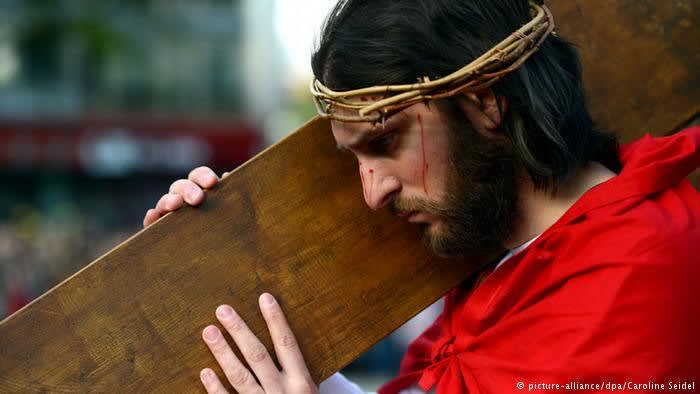2017年4月13日(Thu.) 今日は畑での作業、追加のジャガイモ(種芋)を植えてきました。 今年は3品種、およそ90日後に収穫の予定です。 また、ソラマメは元気よく成長していて満開(?)状態。 有機・無農薬栽培を続けています、自家用レベルですが・・・。 さて、イースターの4日間が始まったとドイツのサイトが伝えています。 ( ニュースソース: DW-DE 4月13日発 )
<原文の一部>
How to celebrate Easter in Germany
Watch out for sugar-coated lambs, fire and lots and lots of chocolate. Here's what to expect during the four-day Easter holiday in Germany.
Everyone knows that the Easter Bunny doesn't lay eggs, but that doesn't stop him from hiding them for children in countries all over Europe and beyond.
A symbol of fertility, spring and new life, eggs have become an integral part of Easter celebrations. In Germany, however, passion for eggs extends well beyond the holiday.

A celebration of life
Christians all over the world celebrate the resurrection of Jesus Christ on Easter Sunday. In Germany, Easter is known as "Ostern" and the commemoration begins a week before, on Palm Sunday, marking Jesus' entry into Jerusalem. The week leading up to Easter is know as Holy Week, or "Karwoche" in German.

Why Easter always falls on a different day
According to the Bible, Jesus was crucified around the time of the Jewish Passover, which was observed at the first full moon following the vernal equinox. Based on the Gregorian calendar, Easter is celebrated on the first Sunday following Passover: that is, depending on lunar cycles, between March 22 and April 25. German pupils look forward to two weeks of vacation surrounding the Easter holiday.

Germany's first Easter Bunnies
It was German scientist Georg Franck von Franckenau who in 1682 first wrote about the tradition of a mythical Easter Bunny that hid eggs in the garden for children to find. The custom was being practiced in the central and southwestern German regions, including Alsace and Palatinate. The tradition stuck - and now kids around the world try extra hard to find the eggs they missed last year.

Eggs grow on trees in Germany
As every farm kid knows, rabbits don't lay eggs. They grow on trees - at least in Germany. Decorating both full-sized outdoor trees and smaller indoor versions with colorful eggs, similar to a Christmas tree, is a centuries-old German Easter tradition. Often, indoor trees are adorned with elaborately decorated porcelain eggs. The custom joins two symbols of life: the egg and the tree.

Chocolate lovers' paradise
Chocolate does not symbolize life, spring or fertility - but it's nevertheless inseparable from Easter. Over 200 million chocoloate bunnies are produced in Germany each year, with around 40 percent being exported abroad. Lindt, pictured, is actually a Swiss company, but has a factory in Aachen, in western-most Germany, and is one of the most common bunny brands.

Sugary sweet Easter lambs
While the egg as a symbol for life dates back to ancient Rome, the symbolism of the lamb is much older. The Jews of the Old Testament sacrificed unblemished lambs in religious rituals. Christians later adopted the image of the sacrificial lamb in reference to Christ's crucifixion. In Germany, lamb isn't just a main course: Sweet Easter lambs formed from cake and powdered sugar are common.
***
申し訳ありませんが、原文の70%ほどを転載しています。 それほど難解な英文ではないと思いますので、原文をサラリと読んで見て下さい。 私はクリスチャンではありませんが、キリストの復活を祝す行事になっていますので、こうした文化もあることは知っておきたいものです。
また、イースターの日が毎年変わる理由も述べられていますので、原文で触れてみて下さい。 ちなみに、今年は4月16日(Sun.)がイースターになっています。
*** 下の写真は、記事内容とは関係ありません。

***
<原文の一部>
How to celebrate Easter in Germany
Watch out for sugar-coated lambs, fire and lots and lots of chocolate. Here's what to expect during the four-day Easter holiday in Germany.
Everyone knows that the Easter Bunny doesn't lay eggs, but that doesn't stop him from hiding them for children in countries all over Europe and beyond.
A symbol of fertility, spring and new life, eggs have become an integral part of Easter celebrations. In Germany, however, passion for eggs extends well beyond the holiday.

A celebration of life
Christians all over the world celebrate the resurrection of Jesus Christ on Easter Sunday. In Germany, Easter is known as "Ostern" and the commemoration begins a week before, on Palm Sunday, marking Jesus' entry into Jerusalem. The week leading up to Easter is know as Holy Week, or "Karwoche" in German.

Why Easter always falls on a different day
According to the Bible, Jesus was crucified around the time of the Jewish Passover, which was observed at the first full moon following the vernal equinox. Based on the Gregorian calendar, Easter is celebrated on the first Sunday following Passover: that is, depending on lunar cycles, between March 22 and April 25. German pupils look forward to two weeks of vacation surrounding the Easter holiday.

Germany's first Easter Bunnies
It was German scientist Georg Franck von Franckenau who in 1682 first wrote about the tradition of a mythical Easter Bunny that hid eggs in the garden for children to find. The custom was being practiced in the central and southwestern German regions, including Alsace and Palatinate. The tradition stuck - and now kids around the world try extra hard to find the eggs they missed last year.

Eggs grow on trees in Germany
As every farm kid knows, rabbits don't lay eggs. They grow on trees - at least in Germany. Decorating both full-sized outdoor trees and smaller indoor versions with colorful eggs, similar to a Christmas tree, is a centuries-old German Easter tradition. Often, indoor trees are adorned with elaborately decorated porcelain eggs. The custom joins two symbols of life: the egg and the tree.

Chocolate lovers' paradise
Chocolate does not symbolize life, spring or fertility - but it's nevertheless inseparable from Easter. Over 200 million chocoloate bunnies are produced in Germany each year, with around 40 percent being exported abroad. Lindt, pictured, is actually a Swiss company, but has a factory in Aachen, in western-most Germany, and is one of the most common bunny brands.

Sugary sweet Easter lambs
While the egg as a symbol for life dates back to ancient Rome, the symbolism of the lamb is much older. The Jews of the Old Testament sacrificed unblemished lambs in religious rituals. Christians later adopted the image of the sacrificial lamb in reference to Christ's crucifixion. In Germany, lamb isn't just a main course: Sweet Easter lambs formed from cake and powdered sugar are common.
***
申し訳ありませんが、原文の70%ほどを転載しています。 それほど難解な英文ではないと思いますので、原文をサラリと読んで見て下さい。 私はクリスチャンではありませんが、キリストの復活を祝す行事になっていますので、こうした文化もあることは知っておきたいものです。
また、イースターの日が毎年変わる理由も述べられていますので、原文で触れてみて下さい。 ちなみに、今年は4月16日(Sun.)がイースターになっています。
*** 下の写真は、記事内容とは関係ありません。

***









